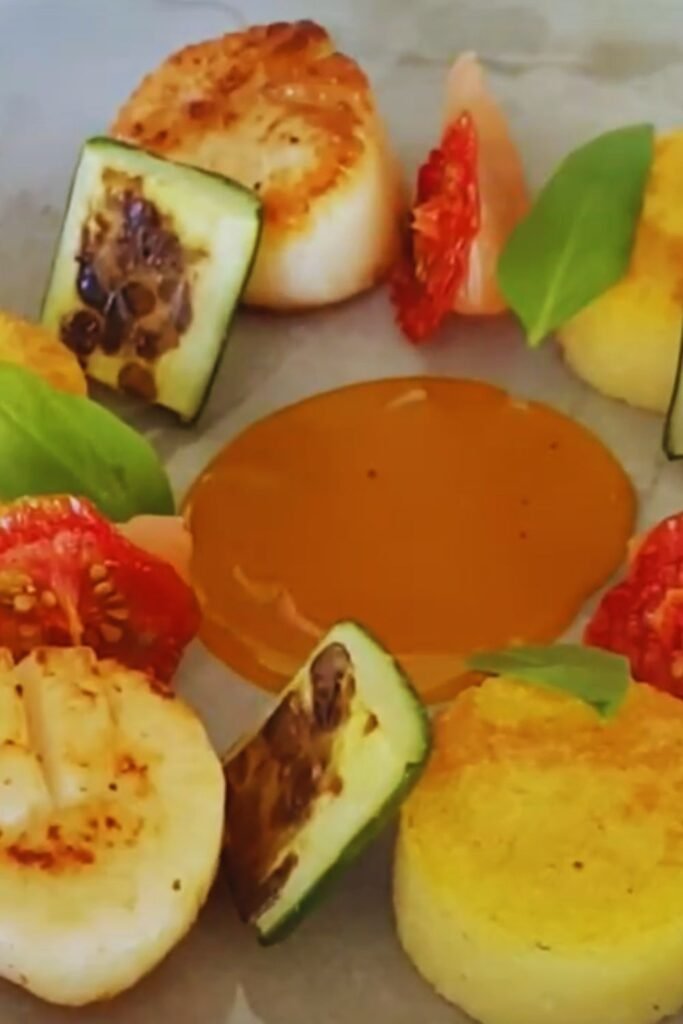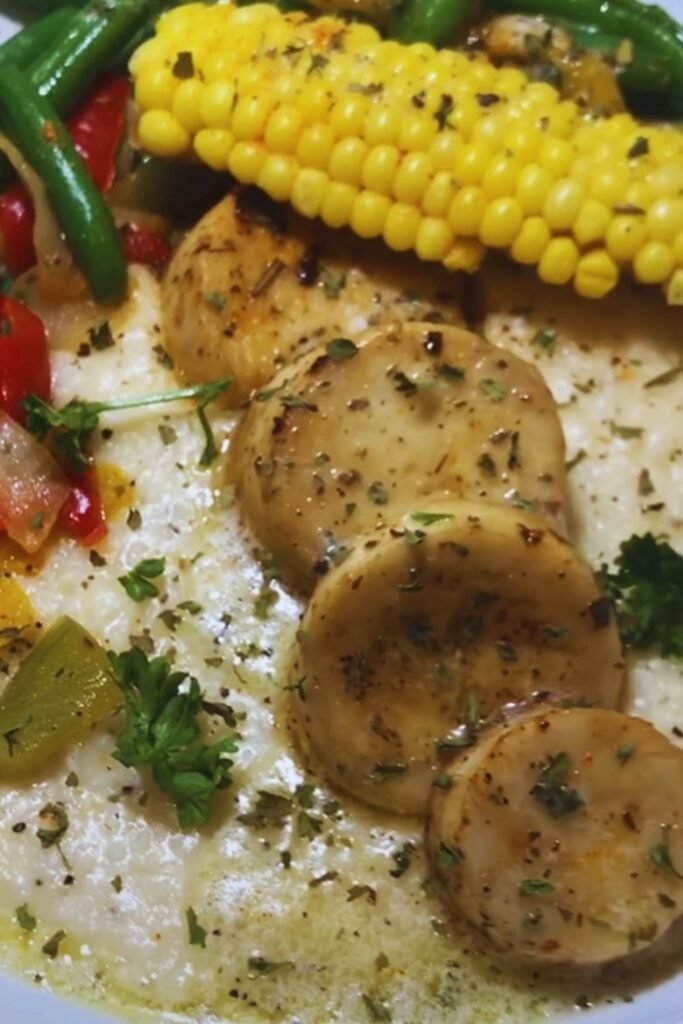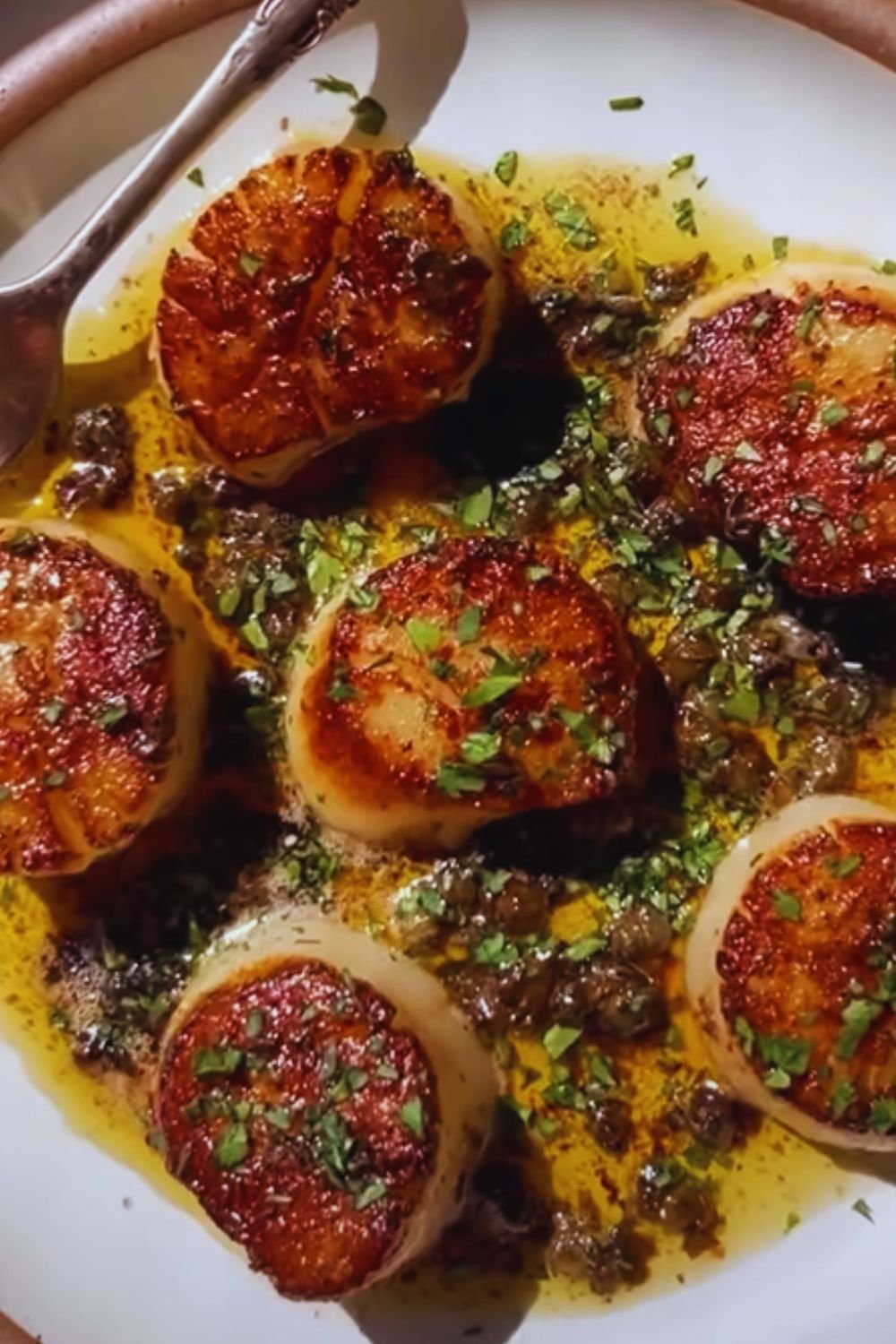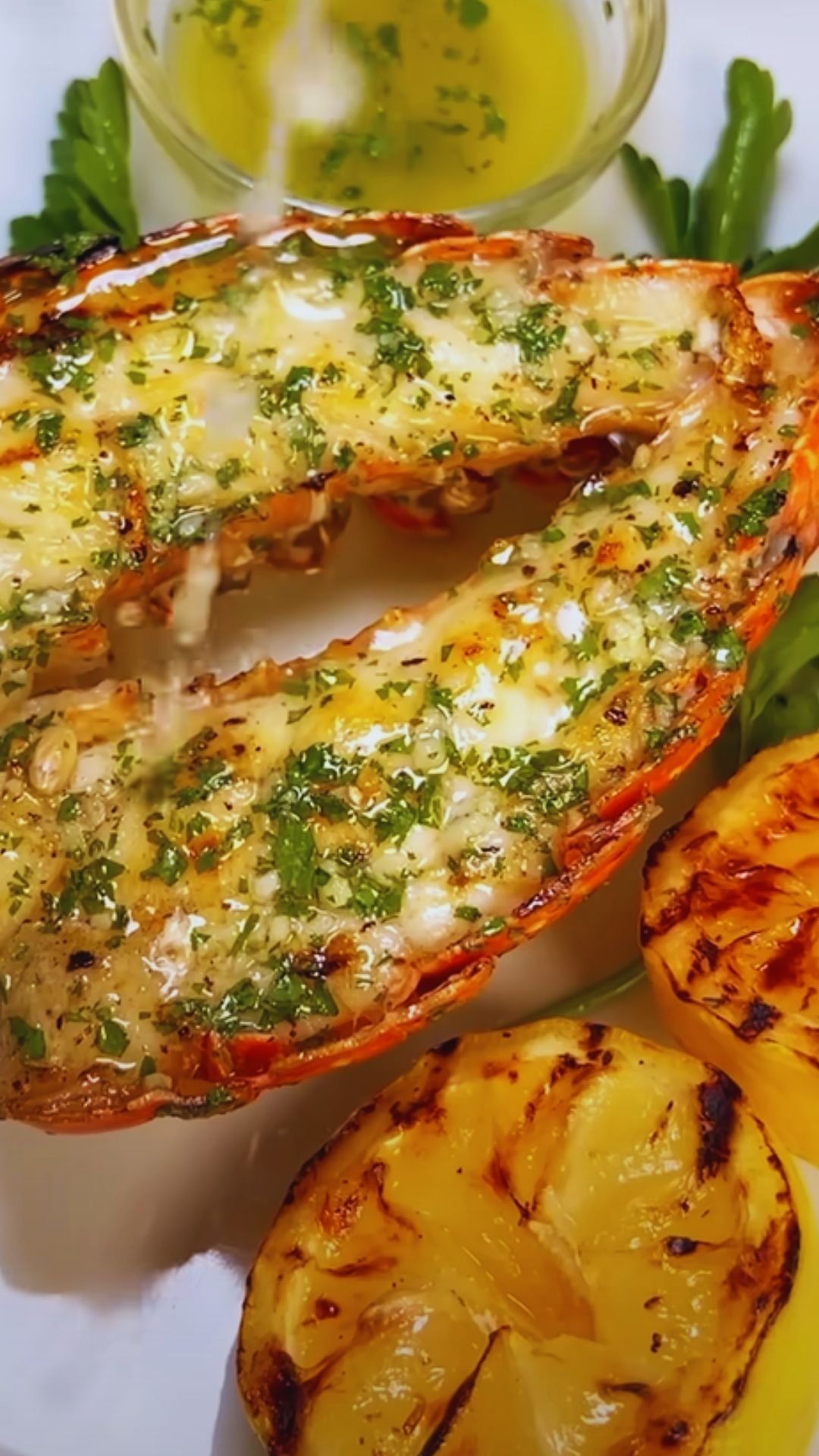There’s something magical about the first time you experience properly prepared Scallops Meunière. I still remember my initial encounter with this classic French dish—the delicate sweetness of the scallops, the nutty aroma of brown butter, and that perfect golden crust that gives way to the tender flesh beneath. It was a revelation that sparked my culinary journey into French cooking, and today I’m thrilled to share this elegant yet surprisingly simple preparation with you.
Scallops Meunière might sound fancy (and it certainly tastes that way), but at its heart, it’s a celebration of simplicity—showcasing fresh ingredients with minimal intervention. The term “meunière” refers to both the cooking method and the accompanying sauce, originating from the French word for “miller’s wife,” as the scallops are lightly dusted with flour before being sautéed. When paired with the golden-brown butter sauce accented with bright lemon and fresh herbs, it creates a dish that’s greater than the sum of its parts.
Understanding Scallops: The Star of the Show
Before diving into the recipe, let’s take a moment to understand what makes scallops special and how to select the best specimens for your dish.
Types of Scallops
Scallops are bivalve mollusks with fan-shaped shells and sweet, delicate flesh. For our Scallops Meunière, you’ll need to know the differences between the main varieties available:
- Sea Scallops: Large (about 1.5-2 inches in diameter), sweet, and perfect for searing. These are ideal for our meunière preparation.
- Bay Scallops: Smaller (about ½-¾ inch), more tender, and slightly sweeter. While delicious, they cook very quickly and are less suitable for this particular recipe.
- Diver Scallops: Hand-harvested by divers rather than dredged, making them more environmentally friendly and often of higher quality. They’re usually sea scallops, just collected differently.
Dry vs. Wet Scallops
This distinction is crucial for successful searing:
Dry Scallops:
- Naturally cream-colored or slightly pink
- No added chemicals
- Caramelize beautifully when seared
- Release less moisture during cooking
- Have a sweet, pure flavor
Wet Scallops:
- Treated with sodium tripolyphosphate (STP)
- Bright white appearance
- Absorb additional water (which you pay for by weight)
- Release excess moisture when cooked, preventing proper searing
- Often have a slightly soapy taste
For Scallops Meunière, always choose dry scallops if available. They’re worth the extra cost for the superior flavor and texture they provide.

How to Identify Fresh Scallops
When purchasing scallops, freshness is paramount. Here’s what to look for:
- Smell: Should have a sweet, clean ocean scent—never fishy or ammonia-like
- Appearance: Moist but not milky or dripping; firm with a slight springiness when pressed
- Color: Natural ivory to pinkish hue, not bleached white
- Texture: Firm and dry to the touch, not slimy or sticky
The Essential Ingredients for Perfect Scallops Meunière
The beauty of Scallops Meunière lies in its simplicity, which means each ingredient must shine. Here’s what you’ll need:
| Ingredient | Amount | Notes |
|---|---|---|
| Dry sea scallops | 1 pound (about 12-16 large scallops) | Must be thoroughly dried before cooking |
| All-purpose flour | 3 tablespoons | Just enough for a light dusting |
| Unsalted butter | 6 tablespoons, divided | High-quality European-style preferred for better flavor |
| Olive oil | 2 tablespoons | Helps prevent butter from burning |
| Fresh lemon | 1 medium | For both juice and zest |
| Fresh flat-leaf parsley | 3 tablespoons, finely chopped | For color and brightness |
| Sea salt | To taste | Flaky sea salt is ideal for finishing |
| Freshly ground black pepper | To taste | Freshly ground makes a difference |
| Capers (optional) | 1 tablespoon | Adds a briny counterpoint |
Essential Equipment
While Scallops Meunière doesn’t require specialized equipment, having the right tools makes the process more enjoyable:
- Heavy-bottomed skillet: Preferably cast iron or stainless steel for excellent heat retention and even cooking
- Fish spatula: The thin edge helps flip delicate scallops without damaging them
- Paper towels: For thoroughly drying scallops
- Small bowl: For your flour dredge
- Microplane or zester: For fresh lemon zest
- Instant-read thermometer (optional): For checking the pan temperature
Preparing Scallops Meunière: A Step-by-Step Guide
Preparation Phase
- Prepare the scallops:
- Remove the small side muscle (the tough rectangular bit attached to the side) if present
- Place scallops on several layers of paper towels
- Cover with more paper towels and press gently to absorb moisture
- Let sit for 10 minutes, then replace towels and repeat
- Dry scallops are essential for achieving a proper sear
- Prepare your mise en place:
- Chop parsley finely
- Zest half the lemon and set aside
- Cut lemon in half for juicing later
- Measure out flour into a shallow dish and season with a pinch of salt and pepper
- Have all ingredients within arm’s reach—once cooking begins, things move quickly
Cooking Phase
Searing the Scallops
- Heat a large heavy-bottomed skillet over medium-high heat until very hot (about 400-425°F if using a thermometer)
- Add 2 tablespoons of butter and 2 tablespoons of olive oil to the pan
- Once the butter has melted and the foam subsides, the pan is ready
- Season scallops lightly with salt and pepper on both sides
- Dredge scallops very lightly in the seasoned flour, shaking off excess
- Carefully place scallops in the pan, leaving at least 1 inch between each
- Cook without moving for 1½-2 minutes until a golden-brown crust forms
- Flip once using a fish spatula and cook for another 1-1½ minutes
- Scallops should be golden on both sides but still translucent in the center
- Transfer to a warm plate and tent loosely with foil
Creating the Meunière Sauce
- Reduce heat to medium-low
- Wipe out any burned bits from the pan but leave the fond (browned bits)
- Add remaining 4 tablespoons of butter to the pan
- Allow butter to melt and then cook until it turns amber and smells nutty (about 2-3 minutes)
- Watch carefully—butter can go from browned to burned very quickly
- Remove from heat and add 2 tablespoons of fresh lemon juice (it will sizzle vigorously)
- Return to low heat and whisk to incorporate
- Add 2 tablespoons of chopped parsley and capers if using
- Season with a pinch of salt and pepper
Final Assembly
- Return scallops to the pan and spoon sauce over them
- Alternatively, plate scallops and pour sauce over
- Sprinkle with remaining parsley and lemon zest
- Finish with a few flakes of sea salt

Common Pitfalls and How to Avoid Them
Even experienced cooks can encounter challenges with Scallops Meunière. Here are solutions to the most common issues:
Scallops Don’t Brown Properly
Possible causes and solutions:
- Scallops too wet: Pat dry thoroughly and let rest on paper towels
- Pan not hot enough: Heat pan fully before adding fat and scallops
- Overcrowding the pan: Cook in batches if necessary, keeping at least 1 inch between scallops
- Using wet scallops: Seek out dry-packed scallops from a reputable fishmonger
Scallops Release Too Much Water
Possible causes and solutions:
- Using wet scallops: Switch to dry-packed scallops
- Pan not hot enough: Ensure proper preheating
- Too much flour: Use only the lightest dusting, shaking off excess
- Scallops not dried properly: Allow extra time for thorough drying
Butter Burns Before Scallops Cook
Possible causes and solutions:
- Heat too high: Maintain medium-high heat, not high
- Using only butter: Add oil to increase smoke point
- Pan too thin: Use a heavy-bottomed pan for better heat distribution
Rubbery Scallops
Possible causes and solutions:
- Overcooking: Cook just until opaque with translucent center
- Poor quality scallops: Source fresh scallops from reliable vendors
- Extreme heat: Cook at medium-high rather than high heat
Perfect Pairings: What to Serve with Scallops Meunière
Scallops Meunière is elegant in its simplicity, so accompaniments should complement rather than compete. Here are my favorite pairings:
Vegetable Sides
- Sautéed Spinach with Garlic: The light bitterness contrasts beautifully with the sweet scallops
- Roasted Asparagus with Lemon Zest: Echoes the citrus notes in the sauce
- Pureed Cauliflower: A lighter alternative to mashed potatoes that soaks up the delicious sauce
- Haricots Verts (French Green Beans): Steamed and finished with butter and a sprinkle of sea salt
Starch Options
- Crusty French Bread: Perfect for soaking up every last drop of the meunière sauce
- Wild Rice Pilaf: The nutty flavor complements the brown butter beautifully
- Buttered Egg Noodles: Simple but effective for capturing the sauce
- Fingerling Potatoes: Roasted with herbs and finished with flaky salt
Non-Alcoholic Beverage Pairings
- Sparkling Water with Lemon: The effervescence cleanses the palate between bites
- Iced Tea with Orange Blossom Honey: Subtle sweetness that harmonizes with the scallops
- Fresh Lemonade with Thyme: Herbal and citrus notes echo the sauce components
- Cucumber-Mint Refresher: The cooling effect balances the richness of the butter

Variations on the Classic
While the traditional preparation is perfect as is, here are some thoughtful variations that respect the original while offering new dimensions:
Herb Variations
- Tarragon Meunière: Substitute half the parsley with fresh tarragon for an anise-like note
- Chervil and Chive: These delicate herbs add complexity without overwhelming
- Sage Brown Butter: Add a few fresh sage leaves to the butter as it browns for an autumnal twist
- Preserved Lemon: Replace fresh lemon with finely diced preserved lemon for a more intense flavor
Textural Elements
- Toasted Breadcrumbs: Sprinkle toasted panko or fresh breadcrumbs for added crunch
- Crushed Hazelnuts: The nutty flavor amplifies the brown butter
- Crispy Shallots: Thinly sliced and fried until golden
- Microgreens: A delicate garnish that adds visual appeal and subtle flavor
Regional Adaptations
- Meunière Amandine: Add toasted sliced almonds to the sauce
- Grenobloise Style: Add diced fresh tomato and capers to the sauce
- Mediterranean Twist: Finish with a touch of high-quality olive oil and flaky sea salt
- Asian Influence: Add a few drops of soy sauce and a sprinkle of toasted sesame seeds
The Detailed Nutritional Profile of Scallops Meunière
For those mindful of nutritional content, here’s a comprehensive breakdown of what you’re getting in each serving (approximately 4-5 scallops with sauce):
| Nutrient | Amount Per Serving | % Daily Value* |
|---|---|---|
| Calories | 320 | – |
| Total Fat | 24g | 31% |
| Saturated Fat | 13g | 65% |
| Trans Fat | 0g | – |
| Cholesterol | 95mg | 32% |
| Sodium | 650mg | 28% |
| Total Carbohydrate | 7g | 3% |
| Dietary Fiber | <1g | 3% |
| Total Sugars | <1g | – |
| Protein | 21g | 42% |
| Vitamin D | 2mcg | 10% |
| Calcium | 18mg | 1% |
| Iron | 0.5mg | 3% |
| Potassium | 390mg | 8% |
| Vitamin B12 | 1.8mcg | 75% |
| Selenium | 38mcg | 69% |
| Omega-3 Fatty Acids | 0.3g | – |
*Based on a 2,000 calorie diet
Health Benefits of Scallops
Scallops aren’t just delicious—they’re nutritional powerhouses:
- High-quality protein: Complete protein containing all essential amino acids
- Low in calories: Relative to other protein sources
- Rich in B vitamins: Especially B12, which supports brain health
- Good source of minerals: Particularly selenium, zinc, and phosphorus
- Contains omega-3 fatty acids: Though less than fatty fish, they still provide heart-healthy benefits
Sustainability Considerations
As a responsible cook, I believe it’s important to consider the environmental impact of our seafood choices:
Most Sustainable Scallop Options
- Farmed scallops: Generally have minimal environmental impact
- Hand-dived/diver scallops: Selective harvesting causes minimal damage to ocean floor
- MSC-certified scallops: Look for the blue Marine Stewardship Council label
Options to Avoid
- Dredged scallops without certification: Can damage sea floor habitats
- Scallops from overfished regions: Ask your fishmonger about source
Making informed choices ensures we can enjoy scallops for generations to come.
Frequently Asked Questions
Q: Can I prepare Scallops Meunière in advance for a dinner party?
While the components can be prepared ahead, the dish shines when made à la minute. I recommend prepping your scallops (drying, removing side muscle) and having all ingredients measured and ready. The actual cooking takes less than 10 minutes, so it’s manageable even while entertaining.
Q: How can I tell when scallops are perfectly cooked?
Perfectly cooked scallops should be firm but still slightly yielding when pressed gently, similar to the resistance of a medium-rare steak. Visually, they should be opaque on the outside but still have a slight translucency at the center. The surface should be golden brown, and they should have a slight vertical height rather than being completely flattened.
Q: Can I substitute frozen scallops?
Yes, but with caution. If using frozen, choose dry-packed scallops, thaw overnight in the refrigerator (never at room temperature), and dry exceptionally well before cooking. Fresh is preferable, but high-quality frozen scallops can work in a pinch.
Q: What’s the best pan for searing scallops?
A heavy-bottomed stainless steel or cast iron skillet yields the best results. Non-stick pans won’t provide the same level of caramelization. The pan should be large enough that the scallops aren’t crowded, which would cause them to steam rather than sear.
Q: My brown butter turned black quickly. What went wrong?
Brown butter moves from perfect to burned in seconds. Use medium-low heat, watch it constantly, and have your lemon juice ready to add the moment it reaches amber color with a nutty aroma. The milk solids in the butter should be golden brown, not black.
Q: Can I substitute ghee for regular butter?
While ghee has a higher smoke point and won’t burn as easily, it lacks the milk solids that create the characteristic nutty flavor of brown butter. I wouldn’t recommend it for a traditional meunière sauce.
Q: How do I store and reheat leftovers?
Ideally, consume all scallops immediately as they don’t reheat well. If you must store leftovers, refrigerate for no more than 24 hours and gently reheat in a pan over low heat just until warmed through. Be aware that reheated scallops will lose some of their delicate texture.
Q: Can I make this dish dairy-free?
Traditional meunière requires butter for its distinctive flavor. However, you could experiment with a high-quality olive oil and a touch of nutritional yeast for umami, though it would be a different dish entirely.
My Personal Journey with Scallops Meunière
I first attempted this dish after returning from a trip to Normandy, where I had tasted it at a small coastal restaurant. My initial attempts were disastrous—soggy scallops swimming in burnt butter. Through trial and error (and many pounds of scallops), I discovered the secrets: thoroughly dry scallops, patience in heating the pan, and vigilance when browning the butter.
Now, Scallops Meunière is my go-to impressive yet simple dinner party dish. It never fails to elicit wide eyes and appreciative murmurs from guests, yet allows me to spend time with them rather than being sequestered in the kitchen all evening.
The dish has taught me that true culinary excellence often lies not in complexity but in mastering simple techniques and respecting quality ingredients. There’s a certain meditative quality to standing over the stove, watching butter transform from pale yellow to a fragrant amber liquid gold, then witnessing the magical transformation of raw scallops into caramelized perfection.
I hope this guide inspires you to try this classic French preparation in your own kitchen. Remember that perfection comes with practice, but even early attempts will be delicious. The journey is part of the pleasure, and few culinary achievements are as satisfying as a perfectly executed Scallops Meunière.


